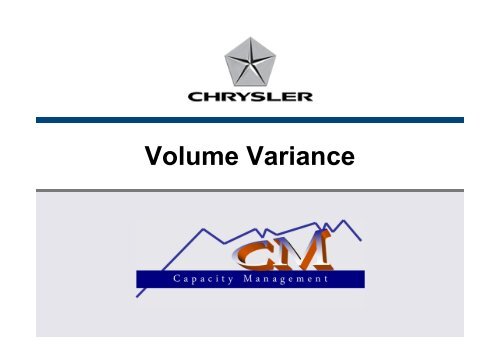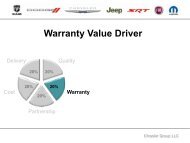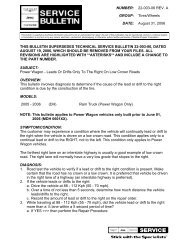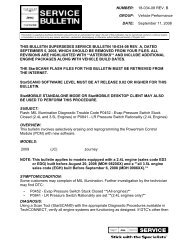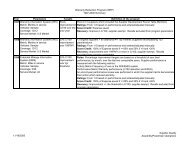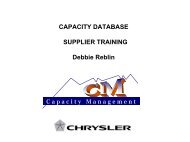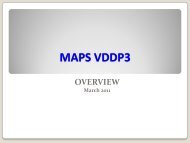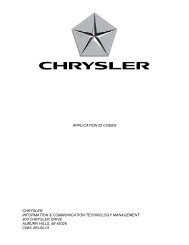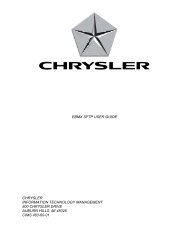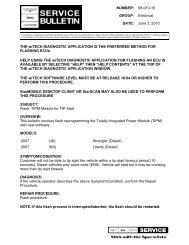Volume Variance - Chrysler
Volume Variance - Chrysler
Volume Variance - Chrysler
Create successful ePaper yourself
Turn your PDF publications into a flip-book with our unique Google optimized e-Paper software.
<strong>Volume</strong> <strong>Variance</strong>
What is it?<br />
Advance Planning Tool<br />
Compares supplier’s Operational<br />
Breakpoints against <strong>Chrysler</strong>’s<br />
average weekly release requirement<br />
Identifies shortfalls and sends an email<br />
to the supplier
Access to <strong>Volume</strong> <strong>Variance</strong><br />
Same as Capacity Database<br />
Thru Covisint<br />
Under Capacity Management<br />
Granted thru YOUR company’s Internal Security Administrator
Capacity Management Homepage
Input a supplier code
<strong>Volume</strong> <strong>Variance</strong> To Do List<br />
Note your EBSC Rating is displayed on this page in red.<br />
All headings that are underlined can be sorted.
Select # of Items Per Page
Parts per page function<br />
Enter amount of items then click on ‘go’. You may scroll through all of the<br />
items. This function works for any part’s list.
Select Part and <strong>Volume</strong> <strong>Variance</strong> Detail Page will<br />
appear
Capacity Database link from <strong>Volume</strong> <strong>Variance</strong>
Release Detail<br />
The <strong>Volume</strong> <strong>Variance</strong> System calculates the release<br />
variances using the releases (830’s and CMIS) that are<br />
available in the System for up to 18 monthly buckets. The<br />
release is a part level requirement to the supply base,<br />
which provides authorization for the purchase of raw<br />
materials and fabrication of those materials into finished<br />
goods.<br />
The average weekly release is compared to the operational<br />
capacity in the Capacity Database. In the event that the<br />
average weekly release is greater than the supplier’s<br />
operational capacity a “variance” is flagged.
Answering & Resolution Options
Resolving <strong>Variance</strong>s<br />
Resolving <strong>Variance</strong>s – Overtime, Banking, Resourced Part, and Part Cancelled.<br />
Postpone Action- Only available in the 16, 17, and 18 Monthly bucket.<br />
Be sure to click on “submit” at the bottom of the screen
Overtime
List of Answer Codes
Resourced Part<br />
Resourced Part is a resolution code. In order for<br />
the system to accept a Resourced Part answer<br />
the part must have multiple POs.<br />
If you are unable to answer Resourced Part and<br />
you no longer supply the part, you may answer<br />
Cannot Produce and explain that the part is<br />
resourced in the Cannot Produce Comment.<br />
Resourced Part answer will resolve the variance.
Part Cancelled<br />
Part Cancelled is a resolution code. In order for<br />
the system to accept a Part Cancelled answer, the<br />
part must be cancelled in the Engineering Bill of<br />
Material System (EBOM).<br />
If you are unable to answer Part Cancelled and<br />
you no longer supply the part, you may answer<br />
Cannot Produce and explain that the part is<br />
cancelled in the Cannot Produce Comment.<br />
Part Cancelled answer will resolve the variance.
Postpone Action<br />
Can only be used in the 16 th , 17 th , & 18 th monthly buckets.<br />
Will “resolve” the variance until it goes into the 15 th monthly bucket.<br />
Used when a supplier anticipates that the release will go down by the<br />
time it reaches the 15 th monthly bucket.
New Tooling<br />
This answer code is used when no other option except additional<br />
tooling will enable you to produce the required quantity of parts. The<br />
System will allow a New Tooling answer if the new weekly capacity is<br />
higher than the highest release requirement; and the time needed to<br />
procure the new tooling is consistent with the time frame that the<br />
requirement is needed.<br />
In other words if it is now September, and you have a shortfall in<br />
October for 7000 parts, and your lead time is 12 weeks to obtain the<br />
new tooling; the System will not accept the new tooling answer. The<br />
reason is that you need the new tooling in 6 weeks and it will not be<br />
ready until 12 weeks.<br />
In the same way, if your new weekly capacity will be 6500 parts and the<br />
shortfall is for 7000 parts, the System will not accept your answer.
New Tooling Requirements
Cannot Produce<br />
Cannot Produce is used when a supplier absolutely<br />
cannot meet the requirements.<br />
The System will not allow the user to enter a short term<br />
capacity. User will be required to enter a Cannot Produce<br />
Comment in order to submit the answer successfully.<br />
Cannot Produce answered variances will remain on the<br />
To Do List as they are not resolved. Only a System Delete<br />
or changing the answer will remove them from the To Do<br />
List.<br />
Make sure the System updated the answer by checking<br />
the status on the To Do list.
Cannot Produce Comments<br />
Cannot Produce answer requires comment. The above example is a good<br />
comment: When it was entered. What is happening. Status of the issue
Mass Update - Match Requirement<br />
To use Mass Update, you can only answer<br />
Overtime or Banking – but not both<br />
Click on Match Requirement and all of the<br />
<strong>Variance</strong>s will be answered and the short term<br />
Weekly capacity will automatically match the<br />
Average weekly release requirement
Mass Update- Enter Capacity<br />
Capacity Option - The drawback to this function is that the highest<br />
possible short term capacity has to be entered to cover the highest<br />
release. In other words you may be committing to a higher capacity than<br />
is needed for all shortfalls in order to resolve the variance.<br />
In this example you would have to enter the capacity of 11839 for all<br />
shortages in order to use this function.<br />
Match Requirement function is a more efficient way to answer the<br />
variance if possible.
Capacity Update<br />
This function will allow the user to edit capacity in the<br />
Capacity Database; and it will update immediately in the<br />
<strong>Volume</strong> <strong>Variance</strong> System instead of waiting for the<br />
weekend update to resolve issues.<br />
If the capacity entered is more than the release<br />
requirement, the variance will system delete.
Short Term Capacity<br />
Important! Short Term Capacity is a commitment. The user is<br />
expected to provide the quantity entered. Never enter a short term<br />
capacity that you are unable to ship. The System will accept the<br />
short term capacity as long as it meets or exceeds the average<br />
weekly release.<br />
Your part will not go into variance again unless the release goes<br />
over the Short Term Capacity
CPV (Capacity Planning <strong>Volume</strong>) <strong>Variance</strong>s<br />
These variances are “Information Only” No action is required. However it is a<br />
“heads up” that <strong>Chrysler</strong> is forecasting a higher volume on your part.<br />
Note the Capacity Database link on the bottom of the <strong>Variance</strong> Detail Screen
Log Screens<br />
Suppliers can view their history of variances for Cannot Produce,<br />
New Tooling, and Resolution History.<br />
Current Resolution Log will allow deletions of previous answers. After<br />
The weekend update and the variance appears again, it can be re-answered
Supplier Ratings - DRIVE Score<br />
Enter Supplier code
Supplier Ratings - DRIVE Score<br />
Suppliers will be rated on the External Balanced Scorecard (EBSC) in the<br />
Supply Cost Driver. The rating is 15% of the overall DRIVe Score.<br />
Suppliers must have 100% of their parts in the Capacity Database completed<br />
with capacity information. Suppliers must have 100% of TRAP Studies<br />
answered in Supplier Collaboration. And Suppliers must answer all<br />
variances in the <strong>Volume</strong> <strong>Variance</strong> System.<br />
Actionable Items in the Capacity Database, <strong>Volume</strong> <strong>Variance</strong> and Supplier<br />
Collaboration Systems that are unanswered after 13 days are considered<br />
late.<br />
Capacity Database and TRAP Study actionable items answered late or<br />
unanswered will calculate a 0 rating.<br />
The <strong>Volume</strong> <strong>Variance</strong> Rating will be based on the following calculation:<br />
◦ A 10% DEDUCTION will be applied for each late variance.<br />
By clicking on the Drive Score link in the Capacity Database dropdown list<br />
you may view your Drive Score.
Contacts<br />
CDhelp@chrysler.com<br />
Debbie Reblin – 248-576-8574
Capacity Management<br />
Supplier Collaboration Tool
Supplier Collaboration Tool<br />
Online web interface to allow <strong>Chrysler</strong> Suppliers to respond<br />
directly to Trapline capacity studies.<br />
Access through <strong>Chrysler</strong> Supplier Portal – Capacity Management<br />
Homepage<br />
System Launch October 2007
Supplier Collaboration Tool<br />
Suppliers will receive an E-Mail from “Pool ID PP and S Trapline<br />
Investigations”<br />
E-Mail will include:<br />
General trapline information<br />
Due date<br />
Body Model Info<br />
Sales Code Info<br />
Link to Supplier Collaboration Tool to respond
Trapline E-Mail Example<br />
You are receiving this notification because a response is required to the capacity study described below.<br />
Supplier Code and Name: 12345, Supplier Corp<br />
Study Name: Investigate increasing WD Production to 530 JPD<br />
Study Description: Marketing and management anticipate the need to build approximately 530 WDs per day after exiting the<br />
launch curve. The current rate of 391 JPD is being viewed as not adequate. Given maximum production in study period, incremental WDs will be<br />
offset with WKs. No new plant calendar available/required.<br />
Model Year: 2011<br />
Date Range Studied: 01/01/2011 - 04/30/2011<br />
Plants Affected: 04012<br />
Vehicle Families Affected: WD, WK<br />
Due Date:<br />
Supplier responses are due: 5/14/2010<br />
Buyer validations are due: 5/20/2010<br />
Supply responses due: 5/27/2010<br />
Director validations due: 5/27/2010<br />
Trapline Analyst Comments:<br />
SUPPLIERS - Please follow the link to Supplier Collaboration below to respond to the trapline. Please respond to each part and common<br />
process group in variance by the due date.<br />
BUYERS - If any tooling quotes are submitted by your supplier, you will need to validate these costs. Once validated, please follow the link to<br />
Supplier Collaboration below and then proceed to the applicable part and/or common process group and click on the not to exceed or<br />
negotiated radio buttons. Negotiated variable costs can only be submitted by the buyer.<br />
TRAPLINE DETAILS<br />
Sales has requested a trapline to increase the production plan for the "WD" built at Jefferson North Assembly Plant beginning in Jan. 2011 for<br />
11MY. The highlights of this study include:<br />
- This trapline increases WD Jobs Per Day from 391 to 530.<br />
- WD 530 JPD will represent 55% of JNAP on straight time (957 JPD) and 49% of JNAP on daily overtime (1073 JPD).<br />
- Peak weekly WD volume will increase from 2,346 to 3,180 on a six day overtime schedule.<br />
- Remix out of WK, overall JNAP peak daily volume will continue at 1073 JPD (9th hour OT).<br />
- All WD module & SPD suppliers must be able to achieve the proposed rates above in order to support this trapline.
Trapline Attachment - Body Model & Sales Code Info
Enter Capacity Management through the <strong>Chrysler</strong><br />
Portal
Through Supplier Collaboration tab select<br />
Supplier Action
Enter Supplier Code then click on Proceed
Trapline Views<br />
• A list of all open Traplines will be displayed for that supplier code as a default.<br />
• To see all, pending, and closed Traplines for this supplier code make selection from<br />
study I.D. status list.
Supplier Collaboration Tool<br />
•To view list of parts in variance, click on the study I.D. number.<br />
•Only parts in variance related to this study will be displayed.
Study ID Definition box<br />
For more information about the Study click on the link below the study name.
Supplier Collaboration Tool<br />
To see the months in variance for an individual part, click on the part<br />
number/CPG number.
Supplier Collaboration Tool<br />
•The screen display is very similar to the Production <strong>Volume</strong> <strong>Variance</strong> Screen.<br />
Resolutions must be provided for all months showing shortfalls.<br />
•Cannot Produce answer is not an option. Require cost and lead time to meet<br />
requirement.<br />
•The only other difference between this and Production <strong>Volume</strong> <strong>Variance</strong> is the “Partial<br />
Plan” resolution.
Supplier Collaboration Tool<br />
• If you select new tooling, please enter the “New Weekly Capacity”, “Dollars $”, “Lead<br />
Time In Weeks” and “Supplier Comments”.<br />
• Comments should include tooling details.
Supplier Collaboration Tool<br />
• Part List screen now shows the updated response code, tooling cost,<br />
variable cost, lead time, new capacity and buyer validation for each specific<br />
part number or Common Process Group.
Supplier Collaboration Tool<br />
• Study ID List screen now shows the updated response code, tooling cost,<br />
variable cost and lead time for each specific study ID.
Conclusion<br />
Partial plan should only be used when the what-if requirement<br />
absolutely cannot be met, but a portion of it can be.<br />
Variable costs for Banking, Overtime or Excess Transportation can<br />
only be entered by your buyer. In order for these costs to be<br />
recognized, you must contact your Buyer and negotiate thru<br />
Purchasing.
Failure to Respond<br />
If you do not respond to the Trapline, you will receive a reminder<br />
and/or delinquency e-mails and phone calls. Your buyer will be copied<br />
on these e-mails as well.<br />
Responses to the Supplier Collaboration System are part of the DRIVe<br />
Rating.


